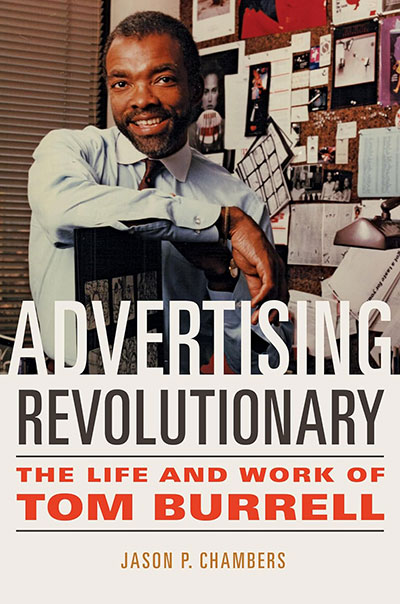Jason P. Chambers’s new book 'Advertising Revolutionary: The Life and Work of Tom Burrell' details ad exec's influence on industry's approach to African Americans

Advertising Professor Jason P. Chambers’s new biography about Tom Burrell, a renowned Black visionary who changed the face of the ad industry for African Americans, will be published on February 6.
 While Advertising Revolutionary: The Life and Work of Tom Burrell (University of Illinois Press) will appeal to those interested in advertising and its history, Chambers said it’s written for a broad audience to enjoy.
While Advertising Revolutionary: The Life and Work of Tom Burrell (University of Illinois Press) will appeal to those interested in advertising and its history, Chambers said it’s written for a broad audience to enjoy.
“If you have an interest in biographies, Chicago, Chicago stories, Chicago entrepreneurs, African American entrepreneurs, what goes into the creation of an advertising campaign, and client relationships, I think you’d be interested in this story,” Chambers said.
Chambers, who is also the associate dean for diversity, equity, and inclusion at the College of Media, describes Burrell as his “favorite person in the history of the [advertising] industry.”
“He started in advertising at a time in which the number of African Americans operating in a professional capacity could have been measured in the dozens,” Chambers said, adding that Burrell was the first Black copywriter at a mainstream agency in Chicago. “He is one of the people who is singularly responsible for helping to get African Americans on TV.”
Burrell not only created a place for African Americans within the advertising industry, but he also changed their representation in advertisements. His concept, known as “Positive Realism,” was relatively simple—present realistic and positive images of African Americans using products and brands—yet it was considered revolutionary at the time.
Chambers said if you saw a television ad for McDonald’s or Coca-Cola in the 1980s or 1990s that depicted African Americans, Burrell’s agency probably created it.
Thanks to Burrell’s early pioneering efforts, there’s a greater breadth of representation in advertising today, Chambers said. More Hispanic Americans, Asian Americans, LGBTQ community members, and people with different physical abilities are included in current brand messaging than ever before.
Despite a more inclusive environment, Chambers still questions how much of advertising today is culturally sensitive and how much is culturally representative.
“It’s one of those things that can have two steps forward and a step back,” he said. “It’s not linear progress, but it’s nonetheless, progress.”
Chambers, who also co-edited Building the Black Metropolis: African American Entrepreneurship in Chicago in 2017, said the catalyst for his second book occurred while doing research for his first book, Madison Avenue and the Color Line: African Americans in the Advertising Industry, published in 2009.
Chambers had the opportunity to interview Burrell on several occasions during that time. He also spent two weeks at Burrell’s ad agency in Chicago through the Advertising Education Foundation Visiting Professor Program, which Chambers says, “deepened my admiration for him.”
The AEF Visiting Professor Program allows professors to visit advertising agencies to enhance their understanding of current developments and practices in advertising and marketing to inform their teaching and research.
Spending one-on-one time with the industry legend before he retired, coupled with a desire to write a biography, is what led Chambers to call Burrell one day in 2011. Chambers recalls standing in his kitchen, calling Burrell’s office, and thinking “it was a long shot because I was fairly certain that he would try to write his own book.”
After some consideration, Burrell opted not to write his autobiography, opening the door for Chambers to write the book.
Chambers spent the next few years interviewing Burrell, mostly at his home in Chicago, along with several other sources who knew him well.
Challenges did arise throughout the process as Chambers soon realized writing a biography, which relies heavily on oral interviews alongside extensive archival research, can prove difficult. There was even a point when Chambers stepped away from writing the book, having concerns about not being able to interview some key figures in Burrell’s life, such as his original business partner who had passed away before Chambers could interview him.
But Chambers found a renewed motivation after an encounter with two of his professional academic heroes at an event in Chicago.
Christopher Robert Reed, professor emeritus at Roosevelt University, and Darlene Clark Hine, professor emerita at Michigan State University, both African American historians, gave him the push he needed to get back to writing the book.
“After I told them about the struggles that I was having in terms of deciding to move on from the book, they both said the same thing,” Chambers said. “They said write it anyway. Just tell the readers what happened and write it anyway.”
His experience has taught him a few lessons about courage and writing that he shares with his students.
“I think the thing that students have to be reminded of is a lack of confidence in work that you’re going to publish is just part of it, and you have to give yourself a license to have those feelings,” he said. “But ultimately the difference between a writer and somebody who writes is that a writer has to make their work public. They have to try and publish.”
—Kelly Youngblood
